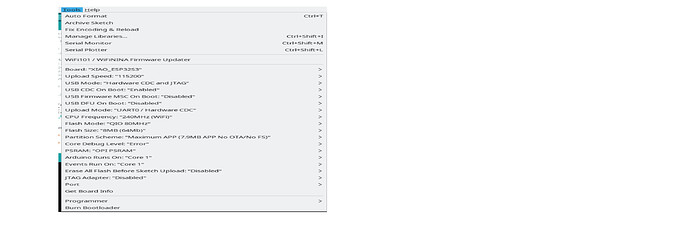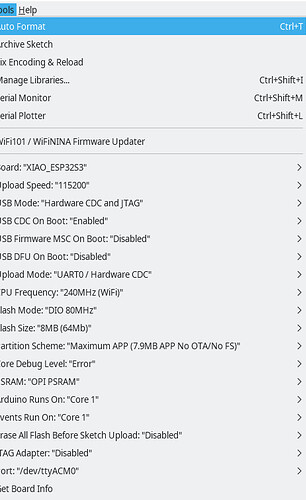Unable to use ESP32S3 Sense
II have a bunch of the XAIO ESP32S3 Sense boards (the ones with cameras). They seem very useful if they would work.
Using the Arduino 2.10 IDE, I can see the default code flailing around looking for WiFi to connect to.
I have the Expressif ESP32 2.09 Arduino support package installed.
I have no difficulty reading the Serial output from the boards on port /dev/ttyACM0 (I am using Linux Mint on AMD64 hardware).
I have the XIAO_ESP32S3 board selected.
I am trying to build/upload the example: /XIAO-ESP32S3-Sense-camera/CameraWebServer retreived under topic “Project II: Video Streaming” at https://wiki.seeedstudio.com/xiao_esp32s3_camera_usage/
Compile/Upload output:
Sketch uses 2926317 bytes (87%) of program storage space. Maximum is 3342336 bytes.
Global variables use 74284 bytes (22%) of dynamic memory, leaving 253396 bytes for local variables. Maximum is 327680 bytes.
esptool.py v4.5.1
Serial port /dev/ttyACM0
Connecting....
Chip is ESP32-S3 (revision v0.1)
Features: WiFi, BLE
Crystal is 40MHz
MAC: 34:85:18:ae:0f:a4
Uploading stub...
Running stub...
Stub running...
Changing baud rate to 921600
Changed.
Configuring flash size...
Flash will be erased from 0x00000000 to 0x00003fff...
Flash will be erased from 0x00008000 to 0x00008fff...
Flash will be erased from 0x0000e000 to 0x0000ffff...
Flash will be erased from 0x00010000 to 0x002dafff...
Compressed 15040 bytes to 10333...
Writing at 0x00000000... (100 %)
Wrote 15040 bytes (10333 compressed) at 0x00000000 in 0.3 seconds (effective 417.8 kbit/s)...
Hash of data verified.
Compressed 3072 bytes to 146...
Writing at 0x00008000... (100 %)
Wrote 3072 bytes (146 compressed) at 0x00008000 in 0.1 seconds (effective 472.1 kbit/s)...
Hash of data verified.
Compressed 8192 bytes to 47...
Writing at 0x0000e000... (100 %)
Wrote 8192 bytes (47 compressed) at 0x0000e000 in 0.1 seconds (effective 629.9 kbit/s)...
Hash of data verified.
Compressed 2926688 bytes to 2057044...
Writing at 0x00010000... (0 %)
Writing at 0x00014e58... (1 %)
Writing at 0x0001a79f... (2 %)
Writing at 0x000259b6... (3 %)
Writing at 0x0002b29a... (3 %)
Writing at 0x0002f6a6... (4 %)
Writing at 0x00033a6c... (5 %)
Writing at 0x000389ec... (6 %)
Writing at 0x0003d682... (7 %)
Writing at 0x000421ef... (7 %)
Writing at 0x00046db8... (8 %)
Writing at 0x0004bb52... (9 %)
Writing at 0x00050597... (10 %)
Writing at 0x0005499f... (11 %)
Writing at 0x00058ddc... (11 %)
Writing at 0x0005d13c... (12 %)
Writing at 0x0006132b... (13 %)
Writing at 0x0006577b... (14 %)
Writing at 0x00069aed... (15 %)
Writing at 0x0006f1f6... (15 %)
Writing at 0x00073a35... (16 %)
Writing at 0x000783bc... (17 %)
Writing at 0x0007cdd7... (18 %)
Writing at 0x000816ca... (19 %)
Writing at 0x00085fa0... (19 %)
Writing at 0x0008a859... (20 %)
Writing at 0x0008f176... (21 %)
Writing at 0x00093abe... (22 %)
Writing at 0x0009838f... (23 %)
Writing at 0x0009cc7b... (23 %)
Writing at 0x000a15a6... (24 %)
Writing at 0x000a5eeb... (25 %)
Writing at 0x000aa86c... (26 %)
Writing at 0x000afa0b... (26 %)
Writing at 0x000b495c... (27 %)
Writing at 0x000b910b... (28 %)
Writing at 0x000bd936... (29 %)
Writing at 0x000c20ba... (30 %)
Writing at 0x000c69cf... (30 %)
Writing at 0x000cb382... (31 %)
Writing at 0x000cfac5... (32 %)
Writing at 0x000d41eb... (33 %)
A serial exception error occurred: Could not configure port: (5, 'Input/output error')
Note: This error originates from pySerial. It is likely not a problem with esptool, but with the hardware connection or drivers.
For troubleshooting steps visit: https://docs.espressif.com/projects/esptool/en/latest/troubleshooting.html
Failed uploading: uploading error: exit status 1
The built-in apps do not work, and I do not know where to go from here.
The documentation, though very pretty, seems to have some very big gaps around some very basic issues.
Dave


